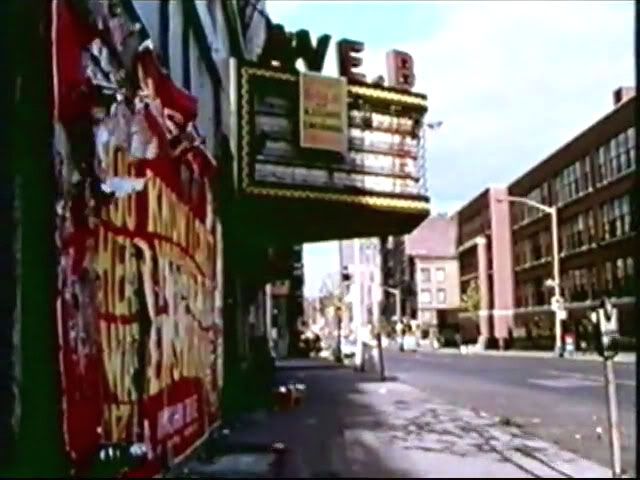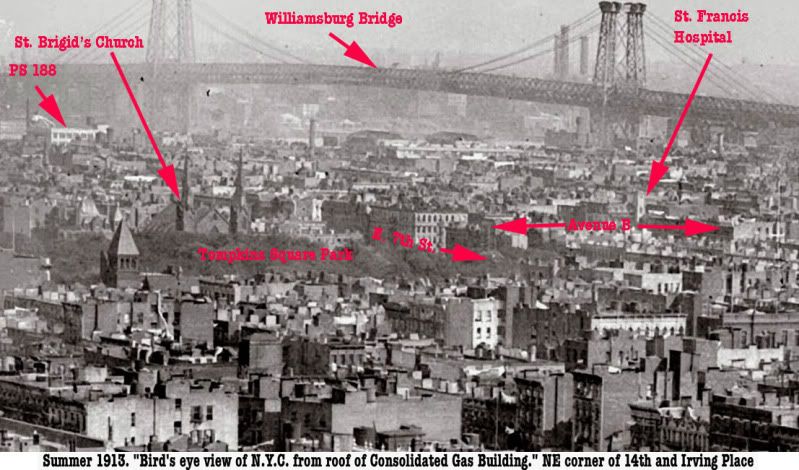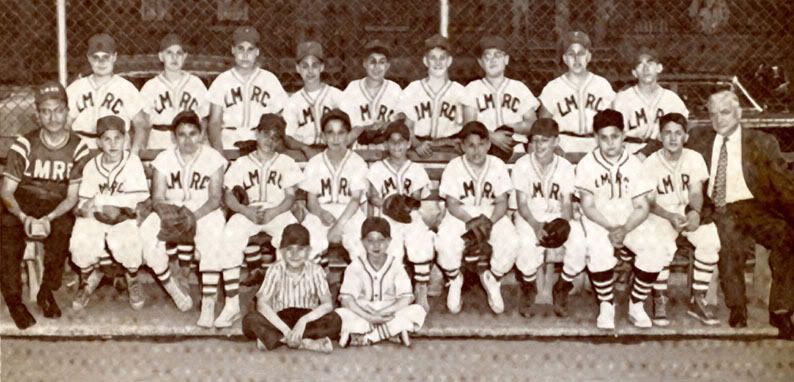Loew’s Avenue B Theatre is part of one of the great rags-to-riches stories of showbiz history. Movie mogul Marcus Loew erected it on the very site of the tenement building where he was born. Needless to say, his birthplace was demolished to make way for the luxurious 1,750-seat theatre, which was designed by Thomas W. Lamb and first opened on January 8, 1913, with vaudeville as its main attraction and movies thrown in just as fillers. The Avenue B Theatre was the top Loew’s house on the Lower East Side until the mid-1920’s, when the circuit took over the Commodore Theatre on Second Avenue, which was a much busier area for entertainment and shopping. The Avenue B Theatre was reduced to playing movies at the end of their Loew’s circuit run, and remained so until its closure around 1957-58. I don’t know if anyone operated the theatre after that. It was eventually demolished and replaced by a nursing facility.
Showing posts with label avenue b. Show all posts
Showing posts with label avenue b. Show all posts
Thursday, September 8, 2011
Avenue B Theater In 1967
I isolated a clip from the 1967 film showing the Avenue B theater, which was located between East 5th and East 4th Streets on the west side.
for more on the theater from cinema treasures
Sunday, February 7, 2010
Saturday, February 6, 2010
Avenue B And 4th Street: Two Views

The overhead view (using Bing maps) allows us to see the courtyard in the new law tenement on the corner, 46-50 Avenue B.
New York State Tenement House Act
One of the reforms of the Progressive Era, the New York State Tenement House Act of 1901 was one of the first such laws to ban the construction of dark, poorly ventilated tenement buildings in the state of New York. Among other sanctions, the law required that new buildings must be built with outward-facing windows in every room, an open courtyard, indoor toilets and fire safeguards.
This was not the first time that New York State passed a public law that specifically dealt with housing reform. The First Tenement House Act (1867) required fire escapes and a window for every room, the Second Tenement House Act (1879) required that windows face a source of fresh air and light, not an interior hallway. An amendment of 1887 required privies interior to the building. The failures of the Second Act - the air shafts proved to be unsanitary as they filled with garbage, bilge water and waste -- led to the 1901 "New Law" and its required courtyard designed for garbage removal.
Prior to these housing laws, most reform was undertaken by philanthropists and private individuals or organizations. This sequence of laws serves as an example of the Progressive belief that cleaner cities made better citizens. Jacob Riis, in his ground-breaking, muck-raking journalistic expose of 1890, How the Other Half Lives: Studies Among the Tenements of New York attributes the reform movement to the fear of contagious disease emanating from the ghettos, especially following an outbreak of smallpox, far more contagious than the cholera and tuberculosis that had long dwelt in the Lower East Side of New York, the hub of immigrant ghetto life. He views the laws and the progressive reform movement that motivated them as a confluence of the cynically-minded with the civic-minded, eventually working towards the benefit of the burgeoning city's labor force.
The reform movement culminated in a prominent Tenement-House Exhibit of 1899 held in the old Fifth Avenue Sherry's, a Gilded Age center of elegant society. The comprehensive exhibit, marshaled by Lawrence Veiller , covered a wide range of urban concerns including bathhouses and parks, pushing reform for the first time far beyond mere building design into the broader concerns of urban planning. The exhibit was followed by a two volume report to the New York State Tenement House Commission, leading directly to the writing of the 1901 New Law. Aesthetically, the New Law coincided with the introduction of Beaux-Arts architecture. The curious sandstone faces and gargoyles and filigreed terracotta of the previous twenty years of tenement design gave way to the more abstractly classical ornamentation of this urbane, international and more grandiose Parisian style. Because the New Law's required courtyard consumed more space than the 1879 law's air shaft, New Law tenements tend to be built on multiple lots or on corner lots to conserve space for dwelling units which are the money-makers and purpose of the structure. A typical Lower East Side or "East Village" street will be lined with five-story, austerely unornamented pre-law (pre-1879) and six-story, fancifully decorated old law (pre 1901) tenements with the much bulkier grand-style New Law Tenements on the corners, always at least six stories tall.
Tuesday, February 2, 2010
80 Years Ago On Avenue B
Avenue b Census
Listed in the census is Gertrude Greene of 102 Avenue B, the girl scout honoree of 1924
The census inspired me to write "Welcome To The World Of Avenue B" in keeping with Mrs. Santa Claus' "Welcome To The World Of Avenue A"
Listed in the census is Gertrude Greene of 102 Avenue B, the girl scout honoree of 1924
The census inspired me to write "Welcome To The World Of Avenue B" in keeping with Mrs. Santa Claus' "Welcome To The World Of Avenue A"
Welcome to the world of Avenue B
Where you hear Dos Vidonya, Spasida
and Arrivederci!
Janet Sobel and John Capotosto are still going steady
Mrs Green is yelling out there window, “Breakfast is ready.”
And that’s the way it goes on Avenue B
Where Ida Clapper invites Dora Oxman over for tea
Vendors selling their Pierogies and Goulash all over the street
Part of all the great big treats called Avenue B
Captain Garrett Nagle And 37-39 Avenue B
Avenue b News
Go know, a Civil War hero on Avenue B along with juicy story of will tampering!
Go know, a Civil War hero on Avenue B along with juicy story of will tampering!
The View From Above Of Avenue B
Earth School Bing
I patched together screen shots from bing maps (which has superior photos than google) of this area
I patched together screen shots from bing maps (which has superior photos than google) of this area
100 Years Ago On Avenue B
St.francis PS 105
There was PS 71 off of 7th Street, St. Francis Hospital off of 5th Street and PS 105 off of 4th Street
There was PS 71 off of 7th Street, St. Francis Hospital off of 5th Street and PS 105 off of 4th Street
What Were Those Short Buildings On Avenue B?
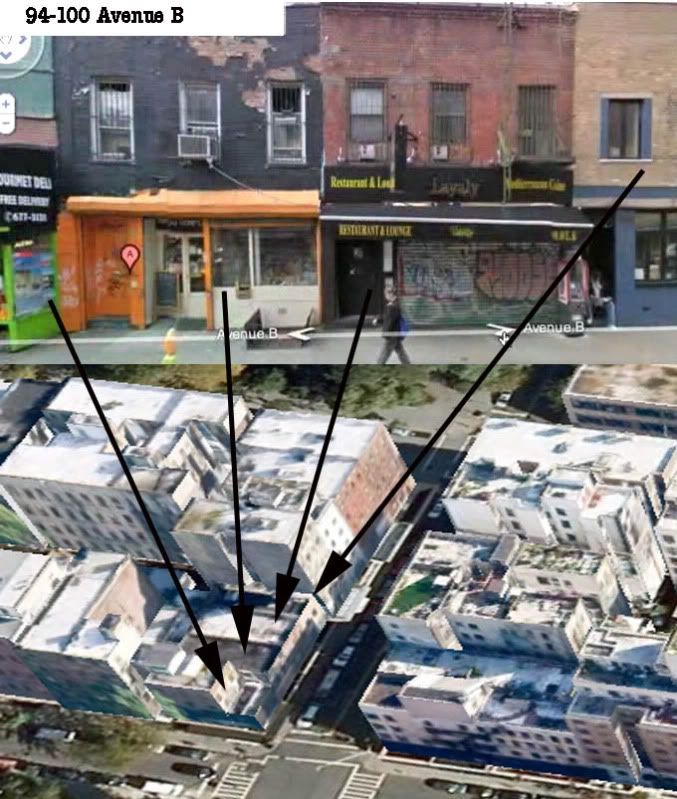
I suspect that they were stables, like the one in Washington D.C. below
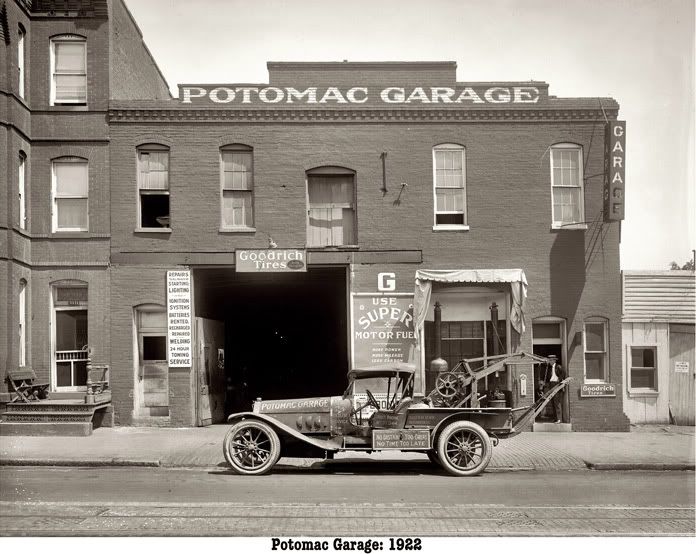
above from shorpy
You can tell it used to be a horse stable, what with the "hay door" above the entrance.
Monday, February 1, 2010
The Charles Theater
Charles 1
The last three images from the pdf above are from evgrieve
next, below from
the nytimes from Victor Washkevich
separate entries from cinema treasures
The last three images from the pdf above are from evgrieve
next, below from
the nytimes from Victor Washkevich
Dear Diary:
Growing up on 16th Street between Avenues B and C before Stuyvesant Town was built meant that respite from summer’s heat was available only if you went to the upscale movie theaters like the RKO Jefferson or the Academy of Music, both farther west on 14th Street. No such luxury could be found at the local movie house, the Bijou Theater, on Avenue B between 11th and 12th Streets.
This two-story theater was strictly a no-frills neighborhood flick house. But when the summer temperature inside became unbearable or cigarette smoke blurred the screen, the ceiling of the Bijou began to ever so slowly slide open from the center toward the edges to provide egress for both heat and Lucky Strike’s blue vapors.
For a 10-year-old like me it was magic — until a sudden thunderstorm came up and the rain began pelting the seats. The roof’s closing speed was also ever so slow, and people scrambled in all directions like it was a fire drill. When it finally closed, we all went back to our seats, gave them a swipe with a handkerchief and never took our eyes off the screen.
The Marx Brothers had their “Night at the Opera.” We had our nights at the Bijou.
Victor Washkevich
separate entries from cinema treasures
I suspect that this was originally the 595-seat Bijou Theatre, which was situated at 193 Avenue B, according to many editions of the Film Daily Year Book. The owners may never have bothered to report a name change because there is no listing for the Charles in any FDYB. But the name was being used at least by 1949, as evidenced by a photo of the Charles marquee at the New York City Housing Authority website. The theatre was a late-run "nabe" and may have even closed before it became an avant-garde showcase in the 1960s. About five years ago, I found the building still standing, but converted to non-theatrical use (partially as an Hispanic church, if I recall correctly).
In research yesterday at the Library of the Performing Arts at Lincoln Center, NYC, I discovered that this was definitely the Bijou Theatre before being re-named the Charles. In 1961, Daniel Talbot, who ran The New Yorker Theatre, took over the Charles, which was then showing Spanish movies, and converted it to a policy similar to that at The New Yorker, but with more emphasis on "new" filmmakers, who were given one night a week to show their latest works to the public at a reduced admision price. In 1969, the Charles was taken over by Radley Metzger, who also owned Audubon Films. He might have been the last person to operate the theatre before it closed.
During the 60's when the neighborhood was hispanic/puerto-rican and hippies, my loving, now deceased aunt and her frisky handed boyfriend took me to the Charles theatre to see " the Killing of Sister George". I guess I was about 6 or 7, strange movie, I do remember breasts and murder, but mostly what I remembered was that my aunt and boyfriend only watched a quarter of the movie (lol). It was a small theatre, sat about 500, and a big " CHARLES" on the marquee. Thanks Aunt Dolores.
I also believe the Charles Theatre opened as the Bijou Theatre with the name change occuring around 1945.
In June of 1968 the Charles had a double bill of "Guess Whos Coming to Dinner" & "Luv".
I believe Radley Metzger's steamy "Camille 2000" got audiences hot and bothered there for a while in 1969.
I re-call seeing "Claire's Knee", "2001", and perhaps "Satyricon" there circa 1970. I can't rememberwhen it actually closed but must have been shortly afterwards, perhaps 1972-73
Subscribe to:
Posts (Atom)

